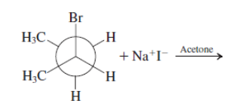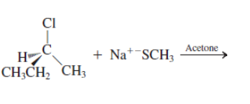
Concept explainers
a.
Interpretation: The mechanism using curved-arrow notation for the following reaction needs to be determined if reaction is possible:
Concept introduction: A chemical transformation of one substance (reactants) to the other (products) via single or several steps involved in the reaction is known as
b.
Interpretation: The mechanism using curved-arrow notation for the following reaction needs to be determined if reaction is possible:
Concept introduction: A chemical transformation of one substance (reactants) to the other (products) via single or several steps involved in the reaction is known as chemical reaction.
c.
Interpretation: The mechanism using curved-arrow notation for the following reaction needs to be determined if reaction is possible:

Concept introduction: A chemical transformation of one substance (reactants) to the other (products) via single or several steps involved in the reaction is known as chemical reaction.
d.
Interpretation: The mechanism using curved-arrow notation for the following reaction needs to be determined if reaction is possible:

Concept introduction: A chemical transformation of one substance (reactants) to the other (products) via single or several steps involved in the reaction is known as chemical reaction.
e.
Interpretation: The mechanism using curved-arrow notation for the following reaction needs to be determined if reaction is possible:

Concept introduction: A chemical transformation of one substance (reactants) to the other (products) via single or several steps involved in the reaction is known as chemical reaction.
f.
Interpretation: The mechanism using curved-arrow notation for the following reaction needs to be determined if reaction is possible:

Concept introduction: A chemical transformation of one substance (reactants) to the other (products) via single or several steps involved in the reaction is known as chemical reaction.
g.
Interpretation: The mechanism using curved-arrow notation for the following reaction needs to be determined if reaction is possible:

Concept introduction: A chemical transformation of one substance (reactants) to the other (products) via single or several steps involved in the reaction is known as chemical reaction.
h.
Interpretation: The mechanism using curved-arrow notation for the following reaction needs to be determined if reaction is possible:

Concept introduction: A chemical transformation of one substance (reactants) to the other (products) via single or several steps involved in the reaction is known as chemical reaction.
i.
Interpretation: The product for the following reaction needs to be determined if reaction is possible:
Concept introduction: A chemical transformation of one substance (reactants) to the other (products) via single or several steps involved in the reaction is known as chemical reaction.
j.
Interpretation: The product for the following reaction needs to be determined if reaction is possible:
Concept introduction: A chemical transformation of one substance (reactants) to the other (products) via single or several steps involved in the reaction is known as chemical reaction.
Want to see the full answer?
Check out a sample textbook solution
Chapter 6 Solutions
ORGANIC CHEMISTRY (LL)-PACKAGE
- Calculate the ionization energy of He+ and Li²+ ions in their ground states. Thannnxxxxx sirrr Ahehehehehejh27278283-4;*; shebehebbw $+$;$-;$-28283773838 hahhehdvaarrow_forwardPlleeaasseee solllveeee question 3 andd thankss sirr, don't solve it by AI plleeaasseee don't use AIarrow_forwardCalculate the chemical shifts in 13C and 1H NMR for 4-chloropropiophenone ? Write structure and label hydrogens and carbonsarrow_forward
- 4. Read paragraph 4.15 from your textbook, use your calculated lattice energy values for CuO, CuCO3 and Cu(OH)2 an explain thermal decomposition reaction of malachite: Cu2CO3(OH)2 →2CuO + H2O + CO2 (3 points)arrow_forwardPlease sirrr soollveee these parts pleaseeee and thank youuuuuarrow_forwardIII O Organic Chemistry Using wedges and dashes in skeletal structures Draw a skeletal ("line") structure for each of the molecules below. Be sure your structures show the important difference between the molecules. key O O O O O CHON Cl jiii iiiiiiii You can drag the slider to rotate the molecules. Explanation Check Click and drag to start drawing a structure. Q Search X G ©2025 McGraw Hill LLC. All Rights Reserved. Terms of Use F 3 W C 3/5arrow_forward
- 3. Use Kapustinskii's equation and data from Table 4.10 in your textbook to calculate lattice energies of Cu(OH)2 and CuCO3 (4 points)arrow_forward2. Copper (II) oxide crystalizes in monoclinic unit cell (included below; blue spheres 2+ represent Cu²+, red - O²-). Use Kapustinski's equation (4.5) to calculate lattice energy for CuO. You will need some data from Resource section of your textbook (p.901). (4 points) CuOarrow_forwardWhat is the IUPAC name of the following compound? OH (2S, 4R)-4-chloropentan-2-ol O (2R, 4R)-4-chloropentan-2-ol O (2R, 4S)-4-chloropentan-2-ol O(2S, 4S)-4-chloropentan-2-olarrow_forward
 Organic Chemistry: A Guided InquiryChemistryISBN:9780618974122Author:Andrei StraumanisPublisher:Cengage Learning
Organic Chemistry: A Guided InquiryChemistryISBN:9780618974122Author:Andrei StraumanisPublisher:Cengage Learning
 Organic ChemistryChemistryISBN:9781305580350Author:William H. Brown, Brent L. Iverson, Eric Anslyn, Christopher S. FootePublisher:Cengage Learning
Organic ChemistryChemistryISBN:9781305580350Author:William H. Brown, Brent L. Iverson, Eric Anslyn, Christopher S. FootePublisher:Cengage Learning


